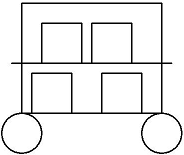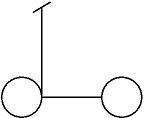Level 2: Patterns and Designs





Level 2 lends itself to drawing vehicles of all types because a circle is so easy to draw!
After the children have experimented at some length with moving the turtle around the screen, discovered its habits and capabilities, they will be eager to explore some new commands. Although the new commands introduced at this level appear simple, there is a lot for a young child to absorb. Take your time at this level and encourage young children to develop interesting patterns using the new movement commands.
About the Level 2 Commands
Your children will likely have discovered how to make circles and squares using Level 1 commands. Now these Level 2 shape tools will allow them to spend less time with repetitive patterns and more time combining these shapes with other patterns and designs.
Level 2 introduces four new turtle commands. Click to read more about these commands.
- S for Square
- C for Circle
- B for Back
- O for Opposite turn
Back and Opposite commands are also short cuts. Your children will probably have figured out how to manage successfully without them in Level 1, but will be delighted to be able to work with these new time-saving and convenient commands.
Check out pictures that children have created in the KL2 Picture Gallery.
Exploring Level 2
Introduce the new commands to the children and give them time to experiment. Don’t be alarmed if a child seems to regress to earlier exploratory behavior. Working through a familiar process while exploring new ideas offers a feeling of security.
Don’t expect immediate “products.” Let the children set their own pace and formulate their own ideas. Begin some of the KL2 Activities only after they seem to be “running dry” of their own ideas.
Patterns
Using single keystrokes in patterns at Level 2 is very exciting. The ability to make instant squares and circles will quickly produce ladders, flowers, and other objects that look very complex. Have the children match the Picture Patterns to the Command Patterns and make up more of their own.
There are two sets of patterns to explore: the Beginning Command Patterns are appropriate for younger learners, as most have just two or three keystrokes to repeat. Older learners will enjoy figuring out the Advanced Command Patterns. Point out that using R instead of L in a pattern, or F instead of B, can change the resulting design dramatically.
Encourage students to create their own patterns. A day or two after they invent a pattern, see if they can recreate it or tell you how they did it. This exercise will indicate their understanding of patterns.
Read about more about exploring patterns.
Design Ideas
The Level 2 Design Ideas show pictures that the children can now try to match or use for inspiration. Don’t worry if none of the projects appeals to the child. In general, don’t make an issue out of “creating something.” Let children relax and have fun!
Food for Thought…
Here are some more questions and puzzlers to think about during Level 2 explorations.
- How many F’s tall is a turtle square?
- Can you draw a square using just B and L commands?
- Can you draw a circle and a triangle using just B and R commands?
- In how many ways can you draw a square on the screen so that each square shares a side with a least one other square?
- How many Right turns equal one Opposite command?
- How many Left turns equal one Opposite command?
Moving On
There is a fine line between pushing the child ahead and staying too long with the same commands. The children may at times show signs of fatigue and boredom. These symptoms may signal the need for a temporary stopping point. The children will have fresh ideas about Level 2 on another day.
A child’s frustration or inattention may in fact be a signal to move on. On many occasions, we have noticed children who seem to be “Kinderlogo”-ed out. At the mention of new commands for the turtle to follow, they light up and a renewed interest suddenly develops. Often, this produces concentration that lasts even longer than during previous sessions.
Give the children all the time they want and need in Level 2. At some point they will show control over these commands, they will have experimented with the additional activities, and you will feel that the time is right. Then move ahead to Level 3.
